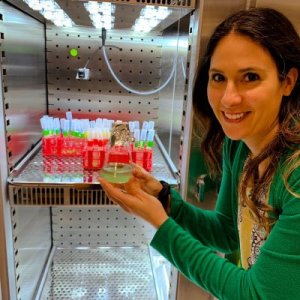Presented By: Cooperative Institute for Great Lakes Research (CIGLR)
Great Lakes Seminar Series: Jenan Kharbush
Exploring the role of nitrogen substrate availability in the ecology of Microcystis-dominated CyanoHABs

About the presentation: “Nitrogen availability” refers to the amounts of biologically usable nitrogen forms relative to demand by the biological community. In cyanobacterial harmful algal blooms (CyanoHABs) dominated by the non-diazotrophic cyanobacteria Microcystis aeruginosa, nitrogen availability is critical for the production of the nitrogen-rich toxin microcystin, and may also play a role in shaping M. aeruginosa strain composition and relative abundance of toxic and non-toxic strains. During the annual CyanoHAB in Western Lake Erie, both the dominant form of nitrogen (organic vs. inorganic) and M. aeruginosa strain composition shift as the bloom progresses, as does the heterotrophic bacterial community composition in M. aeruginosa colonies. Recent metagenomics and culture-based work suggests that some of these heterotrophs may be involved in nitrogen acquisition and cycling processes with Microcystis. In this talk I will discuss some of our recent efforts to understand the influence of nitrogen form on Microcystis bloom ecology, via both strain-specific adaptations and interactions with other community members such as heterotrophic bacteria. This includes examining how nitrogen form influences exometabolite production in cultured M. aeruginosa strains, as well as using nano-secondary ion mass spectrometry (nanoSIMS) to measure how cell-specific nitrogen uptake in field communities changes with bloom phase.
About the speaker: Jenan is an Assistant Professor in the Earth and Environmental Sciences Department at the University of Michigan. She earned her PhD in Chemical Oceanography from the Scripps Institution of Oceanography, where she developed an appreciation for the complexity of microbial life and the outsized influence microbes have on their environment. At U-M, her research group studies how aquatic microorganisms, particularly phytoplankton, acquire and use nitrogen, including during CyanoHABs. They combine laboratory culture experiments with field-based environmental observations to link cellular-level nitrogen cycling processes to large-scale geochemical patterns in both modern and ancient environments.
About the speaker: Jenan is an Assistant Professor in the Earth and Environmental Sciences Department at the University of Michigan. She earned her PhD in Chemical Oceanography from the Scripps Institution of Oceanography, where she developed an appreciation for the complexity of microbial life and the outsized influence microbes have on their environment. At U-M, her research group studies how aquatic microorganisms, particularly phytoplankton, acquire and use nitrogen, including during CyanoHABs. They combine laboratory culture experiments with field-based environmental observations to link cellular-level nitrogen cycling processes to large-scale geochemical patterns in both modern and ancient environments.